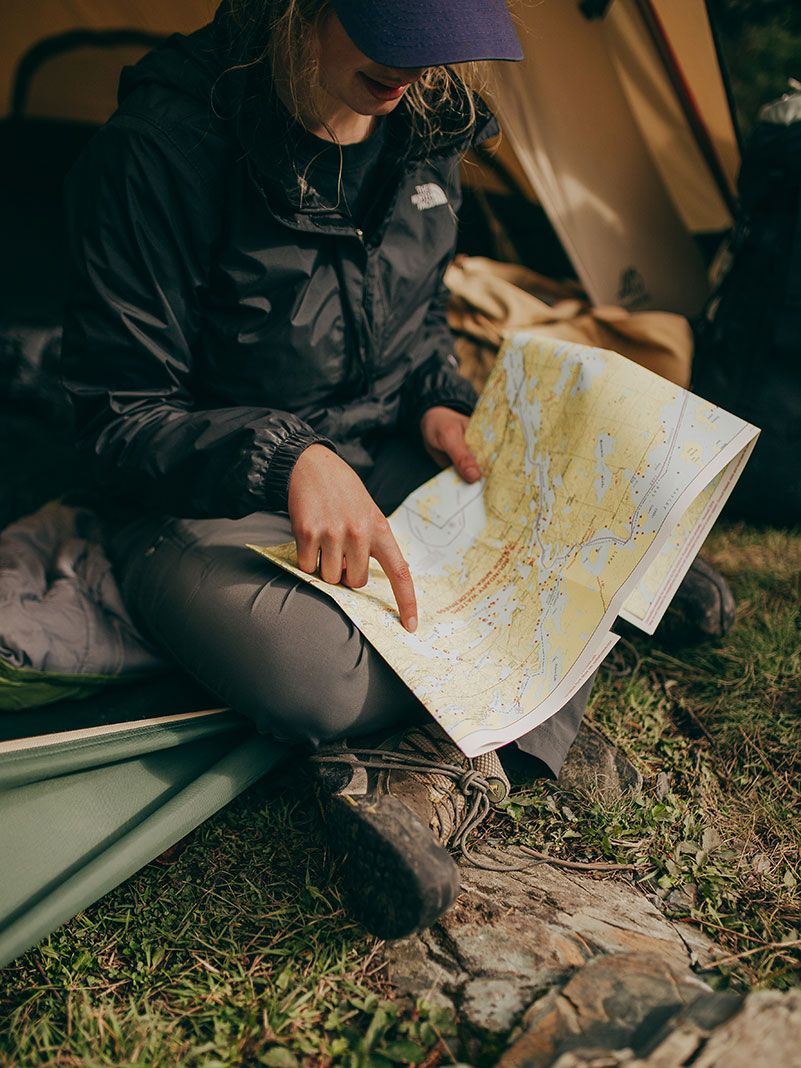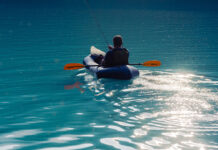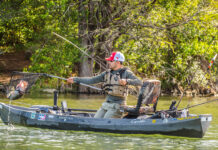Become a better paddler and you can go farther, more efficiently, and have lots of energy left over for the fish fight of your life. Don’t be the angler who scrapes and bangs into the launch—or the one who splashes and slashes to make a turn. These nine expert paddling skills will help you catch more, and have you looking stylish while you do it.
9 Expert Paddling Skills to Level Up Your Game
1 Easy Entry
Entering a kayak while standing in the water or on a low dock is easy if you do it right. The key is to control your center of gravity by keeping your shoulders over the center of the kayak.
Place a hand on each gunnel and plant your butt in the kayak. Then swing one foot into the kayak followed by the second foot. Try to maintain three points of contact at all times and always wear a PFD.
— Jeff Herman

2 One-Arm Paddling
Fishing and paddling don’t mix. You need four arms to do both at once. The solution: learn to paddle with one arm. The key is using your body as the second fulcrum point.
To make a forward stroke on the same side as the hand holding the paddle, hold the paddle so the shaft crosses your body and use your chest or gut as the second fulcrum point. To make a forward stroke on the opposite side from the hand holding the paddle, use your forearm as the second fulcrum.
The same system works to make a back stroke except use the forearm to make a back stroke on the hand side and your underarm to make a back stroke on the opposite side from the control hand. Practice doing one-handed donuts until you can paddle like a pro.
— Rob Choi
3 Paddle Placement
Pay attention to how you place your paddle when you’re not using it. When anchored, it is best to keep the paddle clipped to the boat and out of the way. If it floats away while you’re anchored up you may not get it back.
While drifting and fishing, I keep the paddle in the crook of my upper thighs and my belly; I can make slight adjustments to my drift with one hand. When approaching another kayaker or a dock, lay the paddle between your legs with one blade extending towards the bow and the other blade just past one hip.
— Jeff Herman
4 The Sweep
Use the sweep to spin your kayak like a kid on a skateboard. There are two versions of this stroke.
To perform a reverse sweep, sit up straight and twist your upper body at the waist so you’re facing the side of your boat and the paddle is parallel to the kayak. Place the blade nearest the stern in the water behind your hip and untwist your waist to move the blade to your feet.
To make a forward sweep, again start twisted to face the water but place the blade nearest the bow in the water at your foot. Untwist until the opposite shoulder is pointing towards the bow. Don’t torque your wrist or lean out of the kayak, that makes you unstable. Use your core, your stomach, back and lateral muscles, to power this stroke.
— Jeff Herman
5 You’ve Been Spotted
If you can see a fish, chances are the fish can see you. To keep from being spotted, avoid wearing brightly colored clothing. To avoid being heard, keep your gear from shifting around the kayak and making noise on the deck. Don’t bang the boat with your paddle! Make long accurate casts. If possible, use the wind and current to move towards the fish with the sun to your back. If you are standing, crouch down. Try to make an underhand cast. Use lightweight line and no terminal tackle. Green, black or brown camouflaged line and fluorocarbon leader add stealth. Never let your shadow cross over the fish. Hold your breath, still your heartbeat and think of blue sky.
— Drew Haerer
6 Channel Crossing
Before crossing a boating channel stop, look and listen. Once you are certain the coast is clear, cross quickly. Do not stop to fish or make a phone call. Never race a vessel that is in the boating lane. Remember, a boat traveling with the current will have to maintain speed in order to maintain control.
Boats will pass to the left of a red channel marker when traveling upriver or towards port. Rules of the road say a paddler has right of way when approaching a motor boat, but the might-is-right rule always takes precedence. Most of the time, it is best to let the boat pass and then continue on course.
One short blast on a signal whistle indicates that you will pass the vessel portside (your left when facing the bow) to portside. Make two short blasts to pass starboard to starboard. At night, use a headlamp in addition to a 360-degree white navigation light for added visibility. If you are paddling with a group, stay together as you cross.
— Jeff Herman
7 I Love Maps

It’s true. I love maps. While electronic charts are a valuable tool, old fashioned paper maps or charts still have some advantages. To start, paper maps are cheaper and tougher than an electronic device. And a paper map doesn’t need batteries!
Also, a paper map gives the user a broader view of the surrounding terrain than the small screen on a GPS or smart device without having to zoom in and out or losing detail. Many paper maps also include information such as points of interest, launches, even fishing hot spots and navigation hazards not available on a digital version.
Learning to navigate using a topographic map or marine chart will improve your ability to navigate with an electronic device. Moreover, a paper map can be rolled up and stored in a piece of PVC tubing with end caps or it can be folded and stuck in a map bag. Add a permanent marker to make notes on the map about the area.
— Brad Wiegmann
8 Boat Ramp Basics
Returning from a triumphant day on the water, you want to look smooth when you hit the launch ramp. Instead you charge bow first into the concrete, grind to a halt, teeter on your keel, and flop over into the water. Not cool. The reverse sweep stroke could have saved the day.
A few feet from the ramp, rotate at the waist to turn the paddle face parallel to the kayak. Insert the rear blade into the water behind your hip then untwist your torso to sweep the paddle out and towards the bow. The boat will turn sideways and slide to shore. Then step out on the dry side and take a bow.
— Jeff Herman
9 Bow Rudder Like a Boss
Making a course adjustment with a reverse stroke kills forward momentum, wastes energy and breaks the paddler’s cadence. For a smooth turn that looks cool, use the bow rudder stroke.
While paddling forward, insert the paddle blade like a forward stroke except turn the blade parallel to the kayak. This is called the neutral position. To steer, roll back your lower wrist to open the blade angle slightly and cause the boat to turn toward the paddle. Always look in the direction you want the kayak to go.
Keep your upper arm bent 90 degrees at the elbow and the forearm even with your eyes. This poises your upper arm to compensate for water pushing against the blade. When the boat is heading in the right direction, transition the blade angle into a forward stroke to continue paddling.
This is a great stroke to make slight adjustments while paddling forward, but it also works well when I’m fishing in current or wind. I can use the bow rudder to keep my boat facing into the tide or wind without changing my position.
— Jeff Herman
This article was first published in the Summer/Fall 2013 issue of Kayak Angler. Subscribe to Kayak Angler Magazine’s print and digital editions, or browse the archives.
These expert paddling skills will help you catch more, and have you looking stylish while you do it. | Feature photo: Joshua Wilkinson/Unsplash







#5 is key! I have missed SO many fish that I know of because I could see them, they could see me, and then immediately developed lockjaw. Heartbreaking…